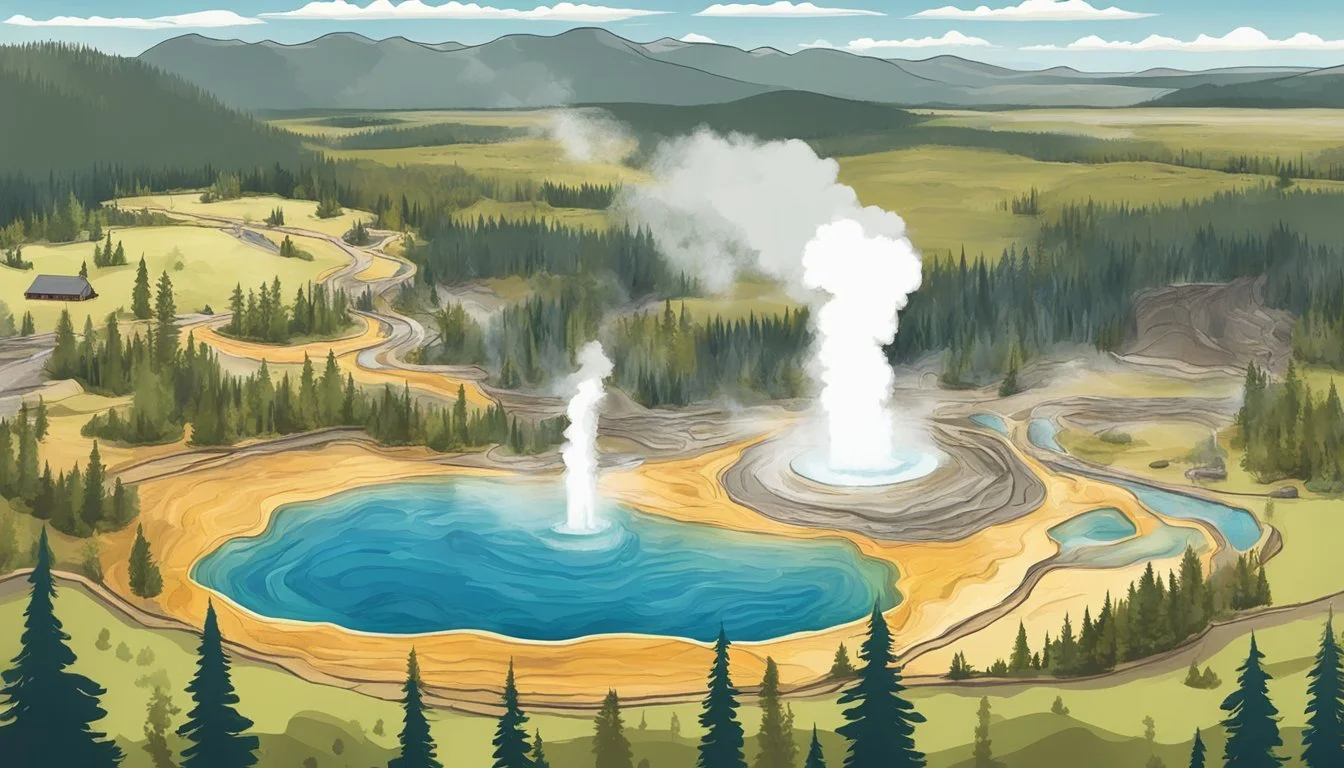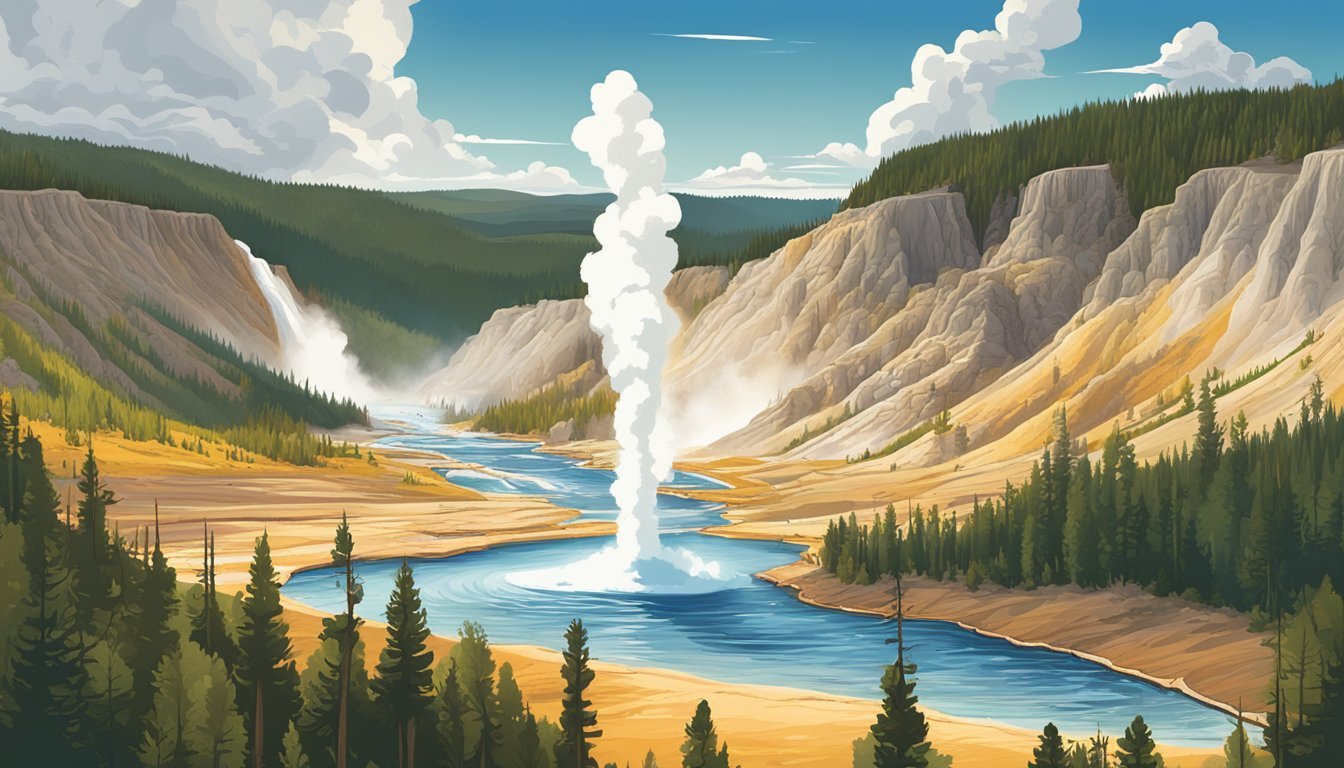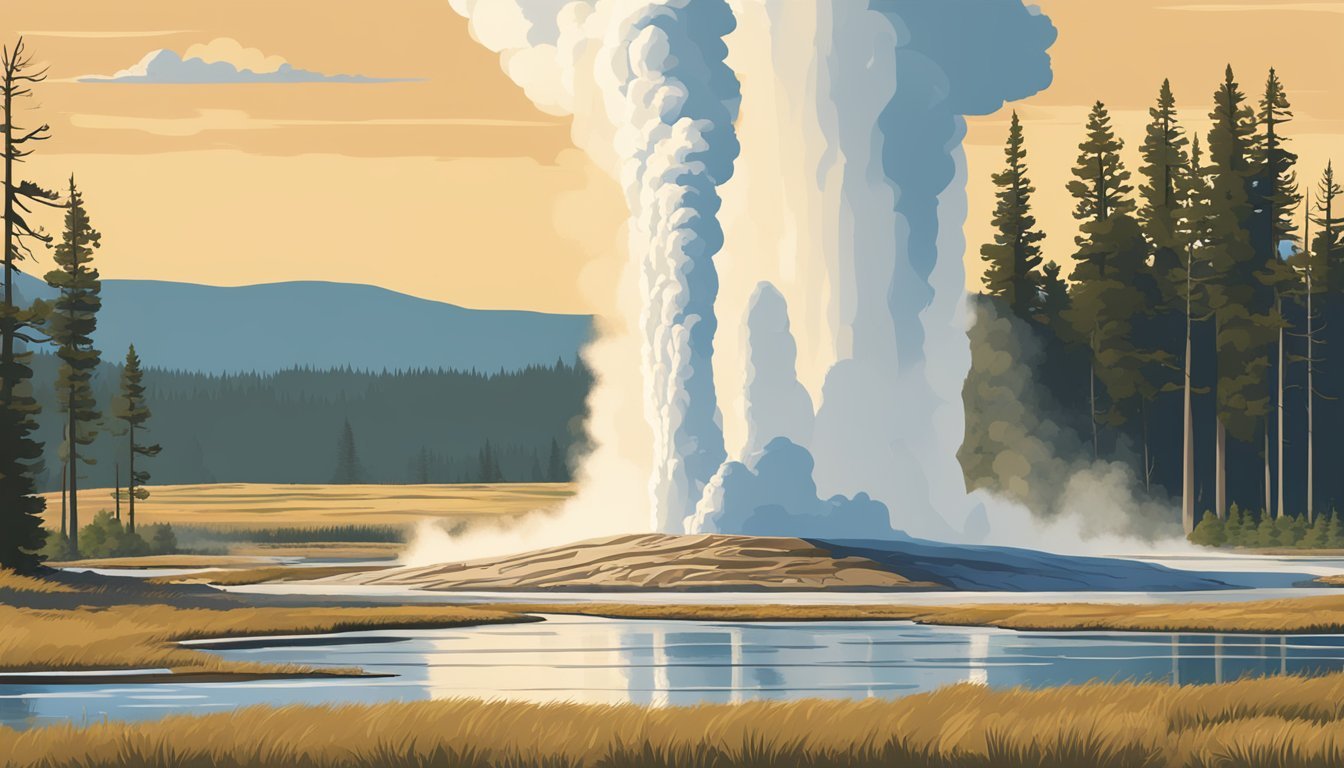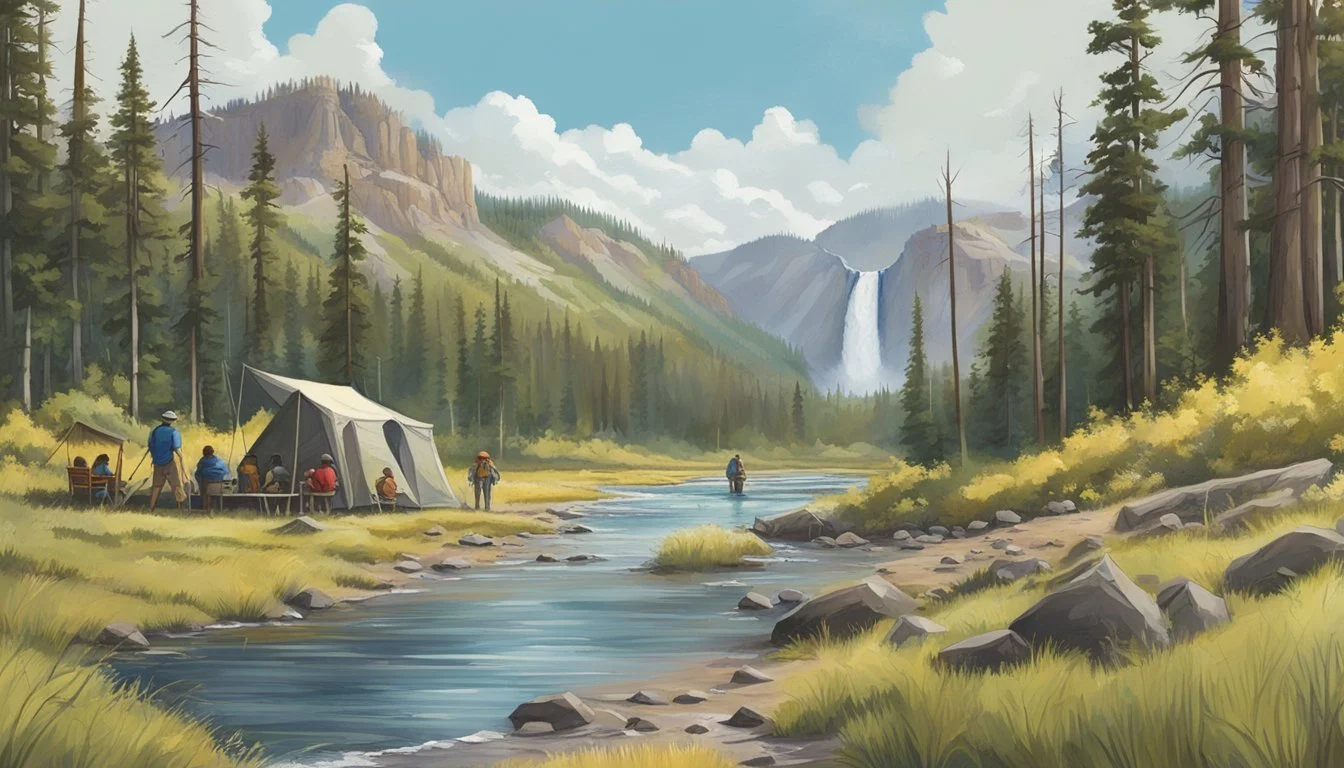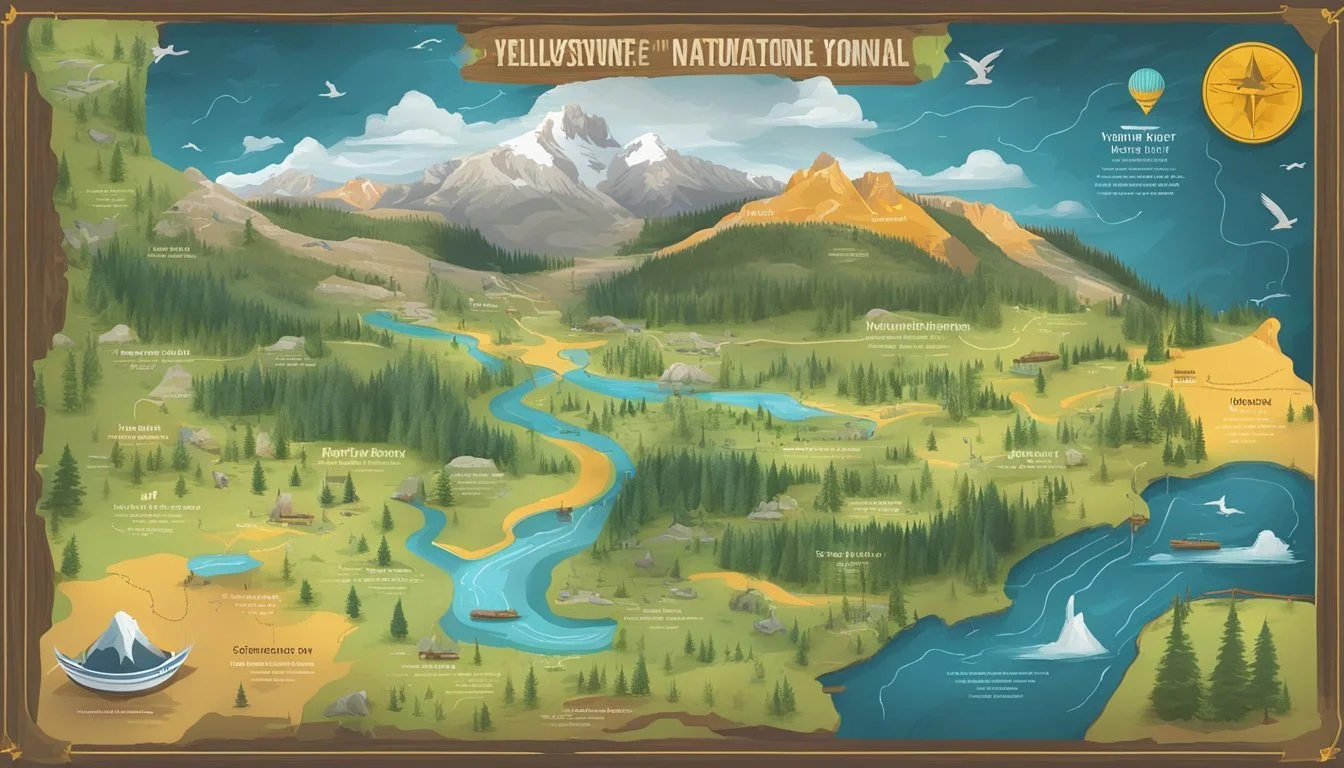Navigate the Adventure: Yellowstone Show Map Reveals America's Iconic Landscapes!
The hit TV series Yellowstone has captivated audiences with its gripping story and stunning visuals. While the show is set in Montana, it brings to life the rugged beauty of the American West through carefully chosen filming locations. The Yellowstone show map spans multiple states, with key scenes shot in Montana, Utah, and Texas.
Viewers eager to explore the real-world settings of Yellowstone can find many iconic locations in Montana. The Dutton family ranch, a central backdrop for the series, is filmed at the Chief Joseph Ranch near Darby, Montana. This working guest ranch offers breathtaking views of the Bitterroot Valley and Trapper Peak, immersing fans in the show's picturesque landscape.
For those planning a visit to Yellowstone National Park itself, it's worth noting that while the show draws inspiration from the park's natural splendor, most filming takes place outside its boundaries. The National Park Service provides detailed maps of Yellowstone's actual geography, including its famous geothermal features and diverse wildlife habitats. These resources allow visitors to navigate the park's vast terrain and experience the real-life wonders that inspired the television series.
Overview of Yellowstone National Park
Yellowstone National Park spans 2.2 million acres across Wyoming, Montana, and Idaho. It features diverse landscapes, unique geothermal features, and abundant wildlife. The park's vast wilderness and geological wonders attract millions of visitors annually.
Historical Significance
Yellowstone became the world's first national park in 1872. Native Americans inhabited the area for thousands of years before European explorers arrived. Early expeditions in the 19th century documented the park's geothermal features and stunning landscapes.
President Ulysses S. Grant signed the Yellowstone National Park Protection Act, preserving the area for future generations. This landmark decision set a precedent for conservation efforts worldwide.
The park's establishment sparked the creation of other national parks and protected areas. Yellowstone's rich history includes the development of park infrastructure, scientific research, and wildlife management programs.
Geographical Layout
Yellowstone's terrain encompasses mountains, forests, lakes, and rivers. The park sits atop a massive volcanic caldera, responsible for its geothermal activity.
The Grand Loop Road, a figure-eight highway, connects major park features. It provides access to popular attractions like Old Faithful, Mammoth Hot Springs, and the Grand Canyon of the Yellowstone.
Yellowstone Lake, the largest high-elevation lake in North America, covers 136 square miles. The park's ecosystem includes:
Geothermal areas with geysers and hot springs
Diverse habitats supporting varied wildlife
Five entrances connecting to nearby communities
Yellowstone National Park maps highlight key features, trails, and facilities. These maps help visitors navigate the park's vast expanse and plan their explorations effectively.
Navigating the Park
Yellowstone National Park offers diverse routes and entry points for visitors to explore its vast landscape. The park's extensive road network and multiple entrance options provide access to key attractions and natural wonders.
Entrance Points
Yellowstone has five main entrances, each offering unique access to different areas of the park. The West Entrance, located in West Yellowstone, Montana, serves as a popular gateway. It provides easy access to Old Faithful and other geyser basins.
The North Entrance in Gardiner, Montana, is the only entrance open year-round to vehicular traffic. It leads directly to Mammoth Hot Springs and the park's headquarters.
The Northeast Entrance near Cooke City, Montana, offers access to the Lamar Valley, known for wildlife viewing. The East Entrance, 53 miles west of Cody, Wyoming, leads to Yellowstone Lake.
The South Entrance, 57 miles north of Jackson, Wyoming, connects Grand Teton and Yellowstone National Parks.
Key Routes and Roads
The Grand Loop Road forms a figure-eight and serves as the main artery through Yellowstone. This 142-mile road connects major park features and attractions.
The road between Mammoth Hot Springs and Norris passes through scenic mountain terrain. The stretch from Canyon Village to Lake Village offers views of the Grand Canyon of the Yellowstone.
The section between Old Faithful and West Thumb takes visitors past numerous geyser basins. The road from Tower-Roosevelt to Canyon Village traverses the dramatic Dunraven Pass.
Firehole Canyon Drive and Blacktail Plateau Drive provide additional scenic routes off the main loop.
Transportation Options
Personal vehicles are the primary mode of transportation in Yellowstone. Visitors can drive their own cars, RVs, or motorcycles throughout the park.
Guided bus tours operate within Yellowstone, offering informative trips to major attractions. These tours are ideal for those who prefer not to drive themselves.
Bicycle rentals are available in some areas, allowing visitors to explore at a slower pace. However, cyclists should be aware of traffic and wildlife on park roads.
During winter, many roads close to regular vehicles. Snowmobiles and snow coaches become the main transportation options for accessing the park's interior.
Maps and Resources
Yellowstone National Park offers a variety of maps and resources to help visitors navigate and explore the park's vast landscape. These tools provide essential information on attractions, trails, facilities, and safety considerations.
Park Maps and Guides
The National Park Service provides official Yellowstone maps in several formats. A printable full map (848 KB PDF) covers both Yellowstone and Grand Teton parks. This double-sided, 11" x 17" map requires appropriate printer settings.
Visitors can access detailed area maps for specific regions like Old Faithful and Mammoth Hot Springs. These maps highlight key features and facilities in each location.
The park's official map includes an outline of the Yellowstone Caldera, the crater left by the last major volcanic eruption. This irregular circular shape spans over 42 miles at its widest point.
Specialized Map Features
Yellowstone maps incorporate various specialized features to enhance visitor understanding. Topographic maps display elevation changes and geographical features across the park.
Relief maps offer a three-dimensional representation of Yellowstone's terrain. These maps help visitors visualize the park's diverse landscape, including mountains, valleys, and geothermal areas.
Some maps highlight geothermal features, allowing visitors to locate and identify the park's famous hot springs, geysers, and mud pots.
Digital and Print Maps
The free, official NPS app includes an interactive Yellowstone map. This digital tool is user-friendly and works well for outdoor navigation.
For those who prefer physical maps, print versions are available at park visitor centers and online. The NPS cartography site offers downloads in PDF, Illustrator, and Photoshop formats for various uses.
Text-only and Braille maps cater to visitors with visual impairments. Audio descriptions of park features complement these accessible map options.
High-resolution digital maps are available online, though some files may be large and require patience when loading.
Major Attractions and Features
Yellowstone National Park boasts an incredible array of natural wonders. From bubbling geothermal features to pristine lakes and rivers, the park offers visitors a diverse landscape filled with unique geological formations and breathtaking vistas.
Geothermal Areas
Yellowstone's geothermal areas are among its most iconic attractions. The Norris Geyser Basin, known for its extreme heat and acidity, features the world's tallest active geyser, Steamboat Geyser. This unpredictable giant can erupt to heights of over 300 feet.
Mammoth Hot Springs showcases a series of travertine terraces. These stepped, mineral-deposited formations create an otherworldly landscape of white, orange, and brown hues.
The Upper Geyser Basin is home to the famous Old Faithful geyser. It erupts approximately every 90 minutes, reaching heights of up to 180 feet. This basin contains the highest concentration of geysers in the world.
Lakes and Rivers
Yellowstone Lake, the largest high-elevation lake in North America, covers 136 square miles. Its vast expanse of crystal-clear water is a haven for fishing and boating enthusiasts.
The park's river systems play a crucial role in its ecosystem. The Yellowstone River, the longest undammed river in the continental United States, winds through the park for nearly 700 miles.
The Madison, Firehole, and Gibbon Rivers offer prime fishing spots and scenic views. These waterways support diverse wildlife and contribute to the park's unique hydrothermal features.
Canyons and Waterfalls
The Grand Canyon of the Yellowstone is a spectacular gorge carved by the Yellowstone River. Stretching for 20 miles, its colorful rock walls plunge to depths of up to 1,200 feet.
Lower Falls, the park's largest waterfall, cascades 308 feet into the canyon. It's a breathtaking sight, especially from Artist Point, which offers panoramic views of the falls and canyon.
Upper Falls, though smaller at 109 feet, is equally impressive. The nearby North Rim Trail provides various vantage points to admire both falls and the surrounding canyon landscape.
Famous Geysers and Springs
Grand Prismatic Spring, in the Midway Geyser Basin, is Yellowstone's largest hot spring. Its vivid rainbow colors, created by heat-loving microorganisms, make it one of the park's most photographed features.
Old Faithful, while not the largest geyser, remains the most famous due to its predictable eruptions. It draws large crowds who gather to witness its regular displays.
The brilliant blue Morning Glory Pool in the Upper Geyser Basin is another notable hot spring. Its striking colors and intricate patterns make it a popular attraction for visitors exploring the park's thermal areas.
Accommodations and Amenities
Yellowstone National Park offers diverse lodging options and essential services for visitors. From historic hotels to rustic cabins and campgrounds, guests can find accommodations suited to their preferences and budgets.
Lodging Options
Yellowstone features several lodges and cabin complexes within the park. The iconic Old Faithful Inn, a National Historic Landmark, provides a rustic yet elegant experience near the famous geyser. Built in 1904, it showcases log and wood-framed construction.
Canyon Lodge and Cabins offers over 500 rooms across five lodge buildings and numerous cabins. This centrally located accommodation provides easy access to the Grand Canyon of the Yellowstone.
Lake Hotel, the park's oldest hotel, sits on the shore of Yellowstone Lake. It combines historic charm with modern amenities.
For a more secluded stay, Roosevelt Lodge Cabins provide a taste of the Old West near Tower Fall.
Campgrounds and RV Parks
Yellowstone maintains 12 campgrounds with over 2,000 sites for tents and RVs. Madison Campground, open from late April to mid-October, is conveniently situated near Old Faithful and the geyser basins.
Grant Village Campground, on the southwest shore of Yellowstone Lake, offers 430 sites and nearby amenities like restaurants and a visitor center.
Fishing Bridge RV Park, exclusively for hard-sided RVs, provides full hookups and is located near Yellowstone Lake. It's the only campground in the park with these services.
Backcountry camping permits are available for those seeking a more remote experience.
Dining and Food Services
Yellowstone offers varied dining options across the park. Full-service restaurants are available at major lodges, serving breakfast, lunch, and dinner.
Quick-service cafeterias and grills provide convenient meal options for visitors on the go. These can be found at locations like Old Faithful Lodge and Canyon Lodge.
Several general stores throughout the park offer groceries and supplies for picnics or campsite meals.
Specialty dining experiences include the Old Faithful Inn Dining Room, known for its grand architecture and local cuisine.
Shopping and Supplies
General stores are located at major developed areas within Yellowstone. They stock camping supplies, groceries, souvenirs, and basic outdoor gear.
Gift shops at lodges and visitor centers sell Yellowstone-themed merchandise, books, and local artisan crafts.
Outdoor stores in nearby towns like West Yellowstone provide more extensive selections of camping and hiking equipment.
Fuel stations are available at Old Faithful, Canyon, Fishing Bridge, Grant Village, and Mammoth Hot Springs for visitor convenience.
Recreational Activities
Yellowstone offers diverse outdoor activities for visitors to enjoy its natural wonders. From scenic trails to fishing spots, wildlife viewing areas to educational programs, the park provides numerous opportunities to explore and connect with nature.
Hiking and Trails
Yellowstone boasts over 900 miles of hiking trails, ranging from easy walks to challenging backcountry treks. Popular trails include the Yellowstone Lake Overlook Trail and the Mystic Falls Trail.
The Grand Canyon of the Yellowstone offers stunning views along the North Rim Trail. For a more strenuous hike, visitors can tackle the Mount Washburn Trail, which rewards with panoramic vistas of the park.
Safety is crucial when hiking in Yellowstone. Visitors should carry bear spray, stay on marked trails, and be aware of wildlife. Trail conditions can vary, so checking with ranger stations for current information is advisable.
Fishing and Boating
Yellowstone's lakes and rivers provide excellent fishing opportunities. Anglers can cast for native cutthroat trout, rainbow trout, and brown trout. Fishing Bridge, despite its name, no longer allows fishing but serves as a prime spot for watching spawning trout.
A Yellowstone fishing permit is required, and specific regulations apply to protect the park's ecosystem. Catch-and-release is encouraged in many areas.
Boating is permitted on most of Yellowstone Lake and Lewis Lake. Several boat launches are available, including at Bridge Bay Marina. Kayaking and canoeing are popular activities, offering unique perspectives of the park's shorelines.
Wildlife Watching
Yellowstone is renowned for its diverse wildlife. The Lamar Valley, often called "America's Serengeti," is a prime location for spotting bison, elk, and wolves. Hayden Valley is another excellent area for wildlife viewing, particularly for grizzly bears.
Early morning and evening hours are typically best for wildlife watching. Visitors should maintain a safe distance from animals and use binoculars or spotting scopes for closer views.
The park's thermal areas, like Mammoth Hot Springs, often attract elk and other wildlife, providing unique photo opportunities.
Ranger-Led Programs and Exhibits
Yellowstone offers numerous educational programs led by knowledgeable park rangers. These include guided walks, evening campfire programs, and Junior Ranger activities for children.
The Museum of the National Park Ranger, located at Norris, provides insights into the history of park rangers and their role in conservation. Visitors can explore exhibits and speak with retired rangers who volunteer at the museum.
Ranger stations throughout the park offer information on current conditions, safety tips, and interpretive displays. The Old Faithful Visitor Education Center features interactive exhibits about the park's geothermal features and ecosystem.
Safety and Regulations
Yellowstone National Park has strict rules and regulations to protect visitors and preserve the natural environment. Visitors must follow all posted signs and ranger instructions for their safety.
Wildlife encounters require caution. It is illegal to approach, feed, or disturb any animals in the park. Maintain a safe distance of at least 100 yards from bears and wolves, and 25 yards from other wildlife.
Geothermal areas pose unique dangers. Stay on designated boardwalks and trails. The thin ground crust can break easily, exposing scalding water and steam underneath.
Camping is only allowed in designated areas. Store food properly to avoid attracting bears. Use bear-resistant food containers or food storage lockers provided at campsites.
Fishing requires a Yellowstone fishing permit. Anglers must follow specific regulations regarding catch limits, bait restrictions, and designated fishing areas.
Vehicles must stay on established roads. Off-road travel is prohibited to protect fragile ecosystems. Obey posted speed limits and be alert for wildlife on roadways.
Park rangers are available to provide information and assistance. In case of emergencies, dial 911 or contact the nearest ranger station for help.
Conservation Efforts
Yellowstone National Park implements numerous conservation initiatives to protect its unique ecosystem. The park focuses on preserving native species and their habitats through careful management and monitoring programs.
Wildlife conservation is a top priority. Efforts include protecting endangered species like grizzly bears and wolves, as well as maintaining healthy populations of bison, elk, and other iconic animals.
The park employs eco-friendly practices to minimize human impact. This includes using renewable energy sources, implementing recycling programs, and promoting sustainable tourism practices among visitors.
Yellowstone's geothermal features receive special protection. Park managers carefully regulate access to these sensitive areas to prevent damage from foot traffic and maintain their natural state.
Water conservation is another key focus. The park works to preserve its rivers, lakes, and wetlands by monitoring water quality and managing watershed health.
Invasive species control is an ongoing effort. Park staff work diligently to remove non-native plants and animals that threaten the native ecosystem.
Yellowstone also emphasizes education and research. The park collaborates with scientists to study climate change impacts and develop adaptive management strategies.
Visitors play a crucial role in conservation. The park encourages responsible behavior through its Leave No Trace program, helping to minimize human impact on the fragile environment.
Planning Your Visit
Proper planning is essential for a successful trip to Yellowstone National Park. Knowing when to go, understanding permit requirements, and being aware of accessibility options and park etiquette will enhance your experience.
Best Times to Visit
Summer is the peak season in Yellowstone, offering warm weather and full access to park facilities. June through August sees the highest visitor numbers and busiest attractions. For fewer crowds, consider visiting in May or September. These shoulder months provide pleasant temperatures and good wildlife viewing opportunities.
Winter offers a unique experience with snow-covered landscapes and opportunities for cross-country skiing and snowmobiling. However, many roads and facilities are closed during this time.
Spring and fall can be unpredictable weather-wise but offer stunning scenery and wildlife activity. Bear in mind that some roads and services may be limited during these seasons.
Permits and Entrance Fees
Entrance fees are required to visit Yellowstone National Park. As of 2025, a 7-day pass for a private vehicle costs $35. Annual passes are available for $70, granting unlimited entry for 12 months.
Visitors planning to camp, fish, or boat within the park need additional permits. Backcountry camping permits are required for overnight stays in the wilderness areas. Fishing licenses are necessary for anglers aged 16 and older.
Boating permits are mandatory for all watercraft, including motorboats, kayaks, and canoes. These can be obtained at various locations throughout the park.
Accessibility Information
Yellowstone National Park strives to accommodate visitors of all abilities. Many visitor centers, lodges, and campgrounds offer wheelchair-accessible facilities. Several trails, including the Mammoth Hot Springs boardwalks and the Lower Geyser Basin boardwalk, are wheelchair-friendly.
Assistive listening devices and sign language interpreters are available for ranger programs with advance notice. The park also provides audio described tours of some areas.
Service animals are permitted throughout the park, including on boardwalks and trails. However, emotional support animals are not allowed in most areas.
Park Etiquette
Respecting wildlife and preserving the natural environment are crucial when visiting Yellowstone. Always maintain a safe distance from animals - at least 100 yards from bears and wolves, and 25 yards from other wildlife.
Stay on designated trails and boardwalks to protect delicate thermal features and vegetation. Do not throw objects into hot springs or geysers, as this can damage these unique natural wonders.
Practice Leave No Trace principles by packing out all trash and leaving natural objects where you find them. Properly store food and scented items to avoid attracting wildlife to campsites.
Obey speed limits and be cautious of wildlife on roads. Use pullouts to safely view animals and scenic vistas without blocking traffic.

